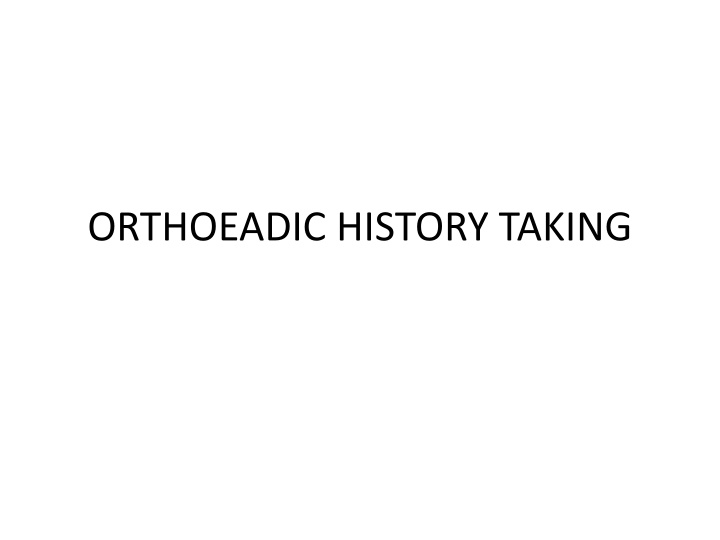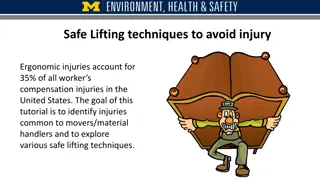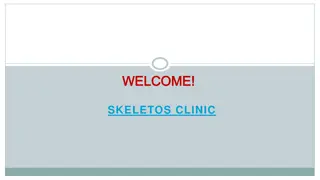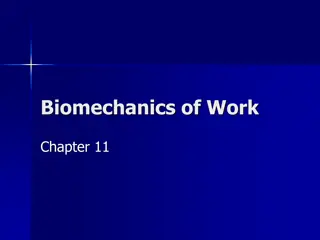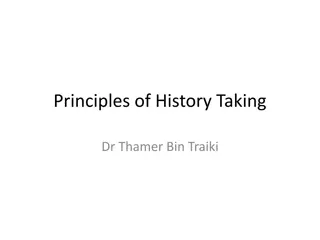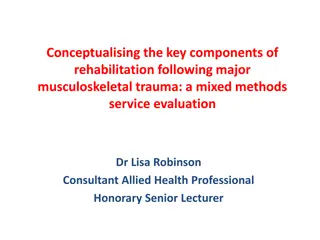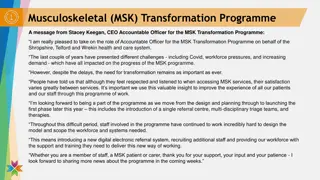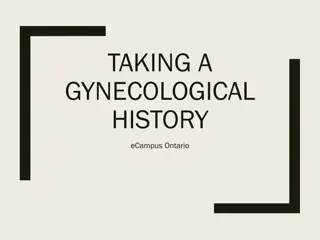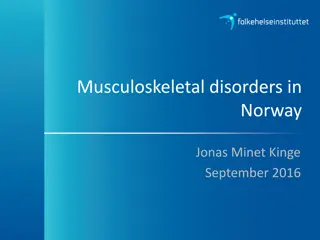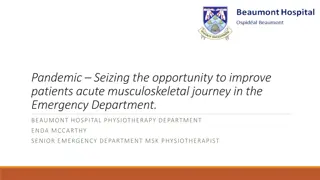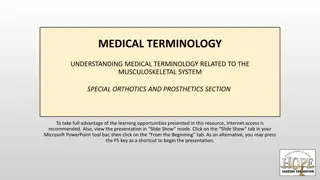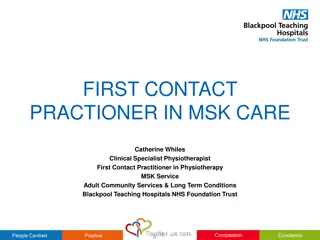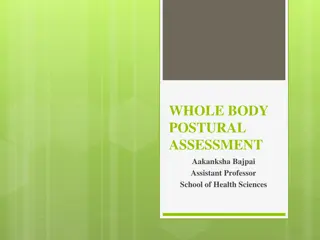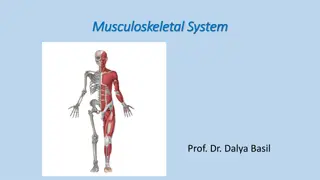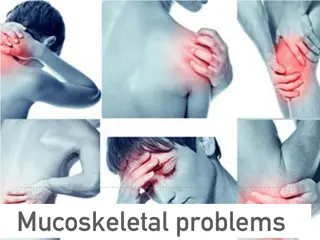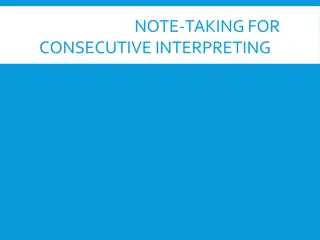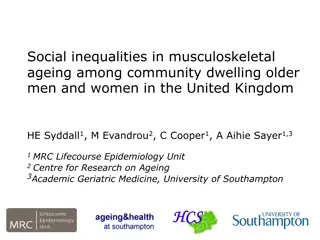Essential Skills for Musculoskeletal History Taking
History taking is crucial in diagnosing musculoskeletal conditions, with a clinician being 60% closer to a diagnosis with a thorough history. This session covers the structure of history, MSK systemic review, pain assessment, swelling evaluation, and more. Students will learn to take a relevant history, identify major musculoskeletal conditions, and understand key concepts in musculoskeletal assessment.
Download Presentation

Please find below an Image/Link to download the presentation.
The content on the website is provided AS IS for your information and personal use only. It may not be sold, licensed, or shared on other websites without obtaining consent from the author.If you encounter any issues during the download, it is possible that the publisher has removed the file from their server.
You are allowed to download the files provided on this website for personal or commercial use, subject to the condition that they are used lawfully. All files are the property of their respective owners.
The content on the website is provided AS IS for your information and personal use only. It may not be sold, licensed, or shared on other websites without obtaining consent from the author.
E N D
Presentation Transcript
History taking skills History taking is the most important step in making a diagnosis. A clinician is 60% closer to making a diagnosis with a thorough history. The remaining 40% is a combination of examination findings and investigations. History taking can either be of a traumatic or non-traumatic injury.
Objective At the end of this session, students should know how and be able to take a MSK relevant history.
Competency expected from the students Take a relevant history, with the knowledge of the characteristics of the major musculoskeletal conditions
STRUCTURE OF HISTORY Demographic feature Chief complaint History of presenting illness MSK systemic review Systemic enquiry PMH PSH Drug Hx Occupational Hx Allergy Family Hx Social Hx
MSK systemic review Pain Stiffness Swelling Instability Deformity Limp Altered Sensation Loss of function Weakness
Pain Location Point to where it is Radiation Does the pain go anywhere else Type Burning, sharp, dull How long have you had the pain How did it start Injury Mechanism of injury How was it treated? Insidious
Pain Progression Is it getting worse or is it remaining stable Is it better, worse or the same When Mechanical / Walking Rest Night nocte Constant Aggravating & Relieving Factors Stairs Start up, mechanical Pain with twisting & turning Up & down hills Kneeling Squatting
Pain Where: location/radiation When: onset/duration Quality: what it feels like Quantity: intensity, degree of disability Aggravating and Alleviating factors Associated symptoms WWQQAA
Swelling Duration Local vs generalised Associated with injury or reactive Soft tissue, joint, bone Rapidly or slowly Painful or not Constant or comes and goes Progression: same size or
Instability Frequency Trigger/aggravated factors Giving way Buckling 2dary to pain I can trust my leg! Associated symptoms Swelling Pain
Deformity Associated with pain & stiffness When did you notice it? Progressive or not? Impaired function or not? Associated symptoms Past Hx of trauma or surgery PMHx (neuromuscular, polio etc)
Limping Painful vs painless Onset (acute or chronic) Progressive or not? Use walking aid? Functional disability? Traumatic or non traumatic? Associated with swelling, deformity, or fever.
Loss of function How has this affected your life Home (daily living activities DLA) Prayer Using toilet getting out of chairs / bed socks stairs squat or kneel for gardening walking distance get & out of cars Work Sport Type & intensity Run, jump
Mechanical symptoms Locking / clicking Loose body, meniscal tear Locking vs pseudo- locking Giving way Buckling 2 pain ACL Patella
Red flags Weight loss Fever Loss of sensation Loss of motor function Difficulties with urination or defecation
Risk factors Age Gender Obesity Lack of physical activity Inadequate dietary calcium and vitamin D Smoking Occupation and Sport, Family History (SCA) Infections, Medication (steroid) Alcohol PHx Musculoskeletal injury/condition, PHx Cancer
Treatment Nonoperative Medications Analgesia How much How long Physio Orthotics Walking sticks Splints Operative
Spine Pain radiation exact location L4 L5 S1 Aggrevating,relieving Hills Neuropathic walking uphill & sitting extension & walking downhill vascular walking uphill generates more work rest standing is better than sitting due to pressure gradient stairs shopping trolleys coughing, straining sitting forward flexion
Spine Associated symptoms Paresthesia Numbness Weakness L4 L5 S1 Bowel, Bladder Cervical myelopathy Clumbsiness of hand Unsteadiness Manual dexterity Red Flags Loss of weight Constitutional symptoms Fevers, sweats Night pain, rest pain History of trauma immunosuppresion
Age of the patient Younger patients - shoulder instability and acromioclavicular joint injuries are more prevalent Older patients - rotator cuff injuries and degenerative joint problems are more common Mechanism of injury Abduction and external rotation - dislocation of the shoulder Direct fall onto the shoulder - acromioclavicular joint injuries Chronic pain upon overhead activity or at night time - rotator cuff problem.
Shoulder Pain Where Rotator Cuff anterolateral & superior deltoid insertion Bicipital tendonitis Referred to elbow Aggravating / Relieving factors Position that symptoms RC: Window cleaning position Instability: when arm is overhead Neck pain Is shoulder pain related to neck pain ask about radiculopathy
Causes AC joint Cervical Spine Glenohumeral joint & rotator cuff Front & outer aspect of joint Radiates to middle of arm Rotator cuff impingement Positional : appears in the window cleaning position Instability Comes on suddenly when the arm is held high overhead Referred pain Mediastinal disorders, cardiac ischaemia
Shoulder Loss of function Home Dressing Associated Stiffness Instability / Gives way Severe feeling of joint dislocating Usually more subtle presenting with clicks/jerks What position Initial trauma How often Ligamentous laxity Clicking, Catching / grinding If so, what position Weakness Rotator cuff especially if large tear Pins & needles, numbness Coat Bra Grooming Toilet Brushing hair Lift objects Difficulty working with arm above shoulder height Top shelves Hanging washing Work Sport
